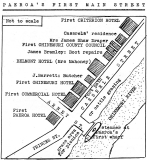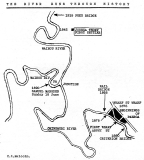Ohinemuri Regional History Journal 28, September 1984
By C.W. Malcolm
The "peace of Hauraki" spoken of by the Maori was not so secure when in 1821, the war canoes of the notorious Hongi made their way along the river to end with the terrible massacre of 1000 inhabitants of Te Totara pa near Thames.
I have before me a map showing nothing but the two rivers as they twist and curve and meander and join; it is an empty map; it creates a feeling of loneliness and isolation; there are no canals, no bridges, no roads, no railway, no towns; I insert a small dot near where the Puke Wharf would be later situated, and I label it: "1842 - Joshua Thorp, Paeroa's first white settler." There is no Puke Road, no Puke Bridge, no road to Netherton. Netherton, like Paeroa does not exist; the river waits for them!
Other settlers will come, like Samuel Chalton, finding his way up the river, landing at Te Kopuru and renaming it Netherton after his home in far-off England, and carving his farm from the virgin bush.
Still the river rolls onward to the firth, its busiest and most exciting days yet to come when gold is discovered in the hills, and a veritable armada of ships, crowded with fortune-seekers, traders, and shop-keepers make it a highway to its navigable limit where Arney Street begins and a cluster of buildings along Cassrells Street establishes the town of Paeroa.
So many have contributed articles on every aspect of the history of the district, filling interesting Journal after Journal. The river, flowing on through unnumbered centuries, is a virtual connecting thread, a time-line which, in teaching days, was used to locate events as they occurred in time. If the river could talk, what a complete historical record we would have, free from error and the slips of fallible human memory.


